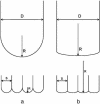From micro to nano contacts in biological attachment devices
- PMID: 12960386
- PMCID: PMC196850
- DOI: 10.1073/pnas.1534701100
From micro to nano contacts in biological attachment devices
Abstract
Animals with widely varying body weight, such as flies, spiders, and geckos, can adhere to and move along vertical walls and even ceilings. This ability is caused by very efficient attachment mechanisms in which patterned surface structures interact with the profile of the substrate. An extensive microscopic study has shown a strong inverse scaling effect in these attachment devices. Whereas microm dimensions of the terminal elements of the setae are sufficient for flies and beetles, geckos must resort to sub-microm devices to ensure adhesion. This general trend is quantitatively explained by applying the principles of contact mechanics, according to which splitting up the contact into finer subcontacts increases adhesion. This principle is widely spread in design of natural adhesive systems and may also be transferred into practical applications.
Figures




References
-
- Breidbach, O. (1980) Mikrokosmos 69, 200–201.
-
- Schliemann, H. (1983) Funkt. Biol. Med. 2, 169–177.
-
- Beutel, R. & Gorb, S. N. (2001) J. Zool. Sys. Evol. Res. 39, 177–207.
-
- Gorb, S. N. (2001) Attachment Devices of Insect Cuticle (Kluwer, Dordrecht, The Netherlands), pp. 1–305.
-
- Gillett, J. D. & Wigglesworth, V. B. (1932) Proc. R. Soc. London Ser. B 111, 364–376.
Publication types
MeSH terms
LinkOut - more resources
Full Text Sources
Other Literature Sources
Molecular Biology Databases

